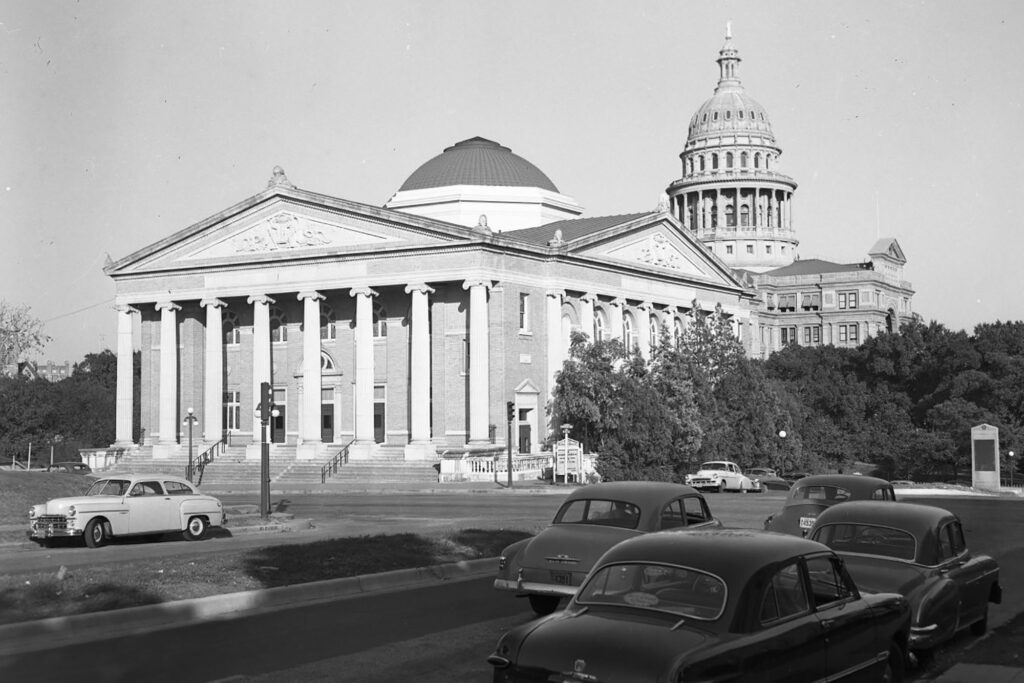- Built:
- 1928
- Alterations:
- 1952
- Architect:
- Sanguinet-Staats-Hedrick & Roy L. Thomas (1928); Carl Henry Stautz (1952)
- Builder:
- J.F. Johnson (Lower Level)
- Style:
- Greek Revival, Neoclassical
Description
The First United Methodist Church of Austin is a monumental neoclassical building in downtown Austin, directly next to the Texas State Capitol. Dating to 1840, this congregation is as old as the City of Austin itself, and its proximity to the Capitol is the physical manifestation of the central role that the church has played in Austin’s spiritual culture. An educational facility was added in 1952, and as of 2025 the worship space is currently undergoing significant restorations to ensure a continued presence as a foundational spiritual community in downtown Austin.
Placemaking
Situated prominently at the corner of 12th and Lavaca Streets, First United Methodist Church is a cornerstone of Austin’s historical and spiritual identity. The neoclassical structure, modeled after significant Greek buildings, was constructed in order to cement and expand the Methodist congregation’s presence in Austin. The strategic location of the church—directly across from the Texas State Capitol—physically illustrates the connection between religious institutions and civic life in Austin’s formative years. This prominent adjacency suggests a deliberate choice to be at the center of influence, reflecting the church’s historical role beyond purely spiritual matters. The congregation has included prominent Austin figures, including members of the state legislature.
The church’s architectural evolution mirrors Austin’s own journey from frontier capital to modern city, highlighting a pattern of continuous investment to meet its growing role in the community. Beginning in 1840, shortly after Austin’s incorporation, early services were held in temporary locations, including in the halls of the Republic of Texas Capitol building, before their first wooden church was completed in 1847 at Congress Avenue and Fourth Street. This original site was notable for hosting 35 doctors in 1853, who gathered there to organize the Texas Medical Association. The congregation later moved to a new brick edifice at Brazos and 10th Street in 1854, and again to a larger building at that site in 1884, before acquiring the current Lavaca Street property in 1921. The repeated relocation and rebuilding of the First United Methodist Church throughout the 19th and early 20th centuries illustrate the dynamic growth and evolving needs of Austin itself; each move and new construction phase mirrors the city’s expansion, its changing urban core, and the congregation’s adaptation to a rapidly developing environment.
After decades of expansion, the congregation acquired a property adjacent to the Capitol that it occupies to this day. The congregation built the lower basement level of the current structure beginning in 1922, and used it as a worship space until the remaining upper floors were completed in 1928. The neoclassical building exemplifies classical grandeur through its symmetrical composition, imposing columns, large stained-glass windows, and prominent dome. Domes were popular for significant public and institutional structures of the era as symbols of importance and timelessness. The congregation has repeatedly demonstrated their dedication to their building, even while they struggled to support their numbers during the suburban flight of the post-war period. Recent and ongoing restoration efforts underscore the congregation’s dedication to preserving their slice of Austin history for future generations.
In recent years, the First United Methodist Church of Austin has aligned itself with the progressive arm of the Methodist Church. In 2013, the congregation voted to become a member of the Reconciling Ministries, with the goal of including people of “all sexual orientations and gender identities in the policy and practice of the United Methodist Church.” In 2017, the Austin congregation made national headlines for announcing that it would no longer officiate any weddings until they were allowed by their governing body to officiate same-sex marriages. This culminated in 2022, when the Methodist Church formally split into the progressive United Methodist Church and the conservative Global Methodist Church. – James Mustillo, AIA
Austin History Center
